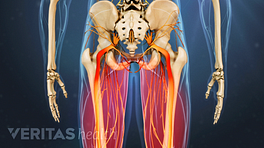Spondylolysis develops most commonly in adolescents, most typically in 10 to 15 year olds. The majority of adolescents with spondylolysis do not have symptoms, or their symptoms are mild and are often overlooked. If the spondylolysis is not correctly identified and managed, there is a chance that the affected area may heal incorrectly, resulting in the possibility of continued stress that can lead to the slippage of spondylolisthesis and recurrent low back pain.
See Answers to Common Spondylosis Questions
Spondylolysis is seen more often in athletes than in people who do not actively participate in sports, although studies differ as to just how much more. Approximately 3% to 7% of the general population is thought to have spondylolysis. It is suspected that spondylolysis occurs most frequently in young athletes who are involved in sports that require repeated hyperextension of the lower back.
- One study found that spondylolysis occurred most frequently in young athletes involved in throwing, bobsledding, artistic gymnastics, rowing, and boxing1;
- Another study found the highest incidence of the condition in diving, wrestling, weightlifting, modern pentathlon and triathlon, and track and field (e.g. from javelin throwing, high jump, and other activities involving hyperextension of the spine)2.
Of course, most athletes involved in the above and other sports do not develop spondylolysis, and at this time it is not known what causes the condition to develop in some people and not in others.
Older adults can also develop spondylolysis because of degeneration in the disc and the facet joints (degenerative spondylolisthesis), which can allow slippage even without a fracture. While it is not known exactly what causes this condition, it is theorized that it probably involves overloading the back part of the facet joints, which can eventually lead to stress fractures.
Spondylolysis diagnosis
Whenever an athlete (especially a young athlete in the 10 to 15 year old age group) experiences low back pain following a traumatic event, spondylolysis must be considered as a potential cause of the pain. Typically, symptomatic spondylolysis involves a complaint of focal low back pain, although the pain can also extend into the buttock or legs.
One orthopedic test that is useful (although not totally conclusive) in diagnosing spondylolysis is the one-legged hyperextension maneuver (also known as the unilateral extension test or Michelis' test). The patient stands on one leg in a position that hyperextends the lumbar spine; he or she then repeats the move on the opposite side. If the test produces pain, this can indicate active spondylolysis.
If spondylolysis is suspected, an anterior (front), posterior (back), and lateral (side) x-ray can confirm the diagnosis. An oblique view x-ray can help determine if the spondylolysis is unilateral (on one side) or bilateral (on both sides of the spine). Finally, to determine if the spondylolysis is active or inactive, a SPECT bone scan or MRI is needed.
For any young individual with low back pain, organic disease must also be considered as a possible cause of back pain. For example, diabetes, and primary or metastatic cancer can cause lower back pain and must be ruled out prior to a definitive diagnosis of spondylolysis.
References
- 1.Soler T, Calderon C. The prevalence of spondylolysis in the Spanish athlete. Am J Sports Med. 2000:28(1)57-62.
- 2.Rossi F, Dragoni S. The prevalence of spondylolysis and spondylolisthesis in symptomatic elite athletes: radiographic findings. Radiography. 2000:28(1):57-62.







